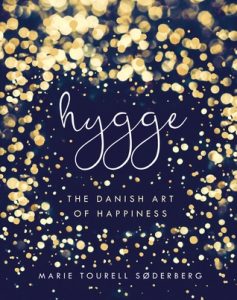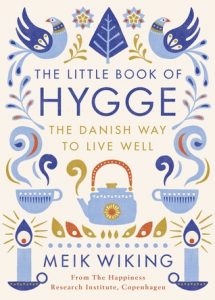 Let’s talk a bit about hygge. (I’ve seen pronunciation keys ranging from hoo-guh to hue-guh to hoo-gah, but one source tells me emphatically that it’s not hoo-gah, and the Visit Denmark page tells me it’s hooga… it’s untranslatable enough into any one English word that we can’t even settle on how to pronounce it using English pronunciation rules! I’m going to go with Oxford dictionary’s pronunciation key, which tells me there are two ways of pronouncing it, somewhere between hue-guh and hju-geh, I believe, the “j” being a soft “y” type of J, if you know what I mean. And as for stress, I’m pretty sure it goes into the first syllable, but I’m not sure.) In fact, I think there’s even possibly a bit of confusion (or perhaps it’s on the part of the authors) as to the etymology of the word as well. Anyway.
Let’s talk a bit about hygge. (I’ve seen pronunciation keys ranging from hoo-guh to hue-guh to hoo-gah, but one source tells me emphatically that it’s not hoo-gah, and the Visit Denmark page tells me it’s hooga… it’s untranslatable enough into any one English word that we can’t even settle on how to pronounce it using English pronunciation rules! I’m going to go with Oxford dictionary’s pronunciation key, which tells me there are two ways of pronouncing it, somewhere between hue-guh and hju-geh, I believe, the “j” being a soft “y” type of J, if you know what I mean. And as for stress, I’m pretty sure it goes into the first syllable, but I’m not sure.) In fact, I think there’s even possibly a bit of confusion (or perhaps it’s on the part of the authors) as to the etymology of the word as well. Anyway.
I’m going to start off this post on hygge with How to Hygge: The Nordic Secrets to a Happy Life by Signe Johansen, pictured above, which is actually quite a departure from the other books that follow in this post. What I mean when I say that is, for a book on hygge, Johansen discusses a much wider range of topics than the others cover. Which is exactly the reason why I’m choosing to start with it, so I don’t lose your interest here by simply covering the hygge clichés you’ve probably already heard before. One thing Johansen stresses throughout the book is that you have to work for it: while hygge brings with it thoughts of relaxation and comfort rather than hard work, it’s definitely something to work towards in your everyday life rather than something you can create by just filling your home with Nordic furnishings (though that certainly helps).
You’ll find that this book is filled with recipes galore, from fika treats to salads to sandwiches and meals, and of course, boozy drinks to help with, as Johansen puts it, adjusting your attitude. But if you look beyond the recipes, a recurring theme is that if you exercise and get out to experience the great outdoors regardless of the weather, you will become the more content for it overall – and it is this contentedness that is, I think, at the heart of hygge. It’s not a striving for happiness, with happiness as the goal, so much as taking care of yourself and indulging in small pleasures, such as treating yourself to cake or chocolate, or taking some time during the day to enjoy fika with your coworkers, your family, and your friends. Fika sounds strikingly similar to afternoon tea to me, except without the highbrow feeling that “afternoon tea” immediately conjures up (at least when I think of it), and Johansen gives you a few recipes for what look like mouthwatering cardamom twists, a cherry bundt cake, and fried doughnuts, among many other such little treats, to get you started.
All in all, I found that while I didn’t exactly learn anything new (apart from the fact that I’m probably using much less cardamom in my cardamom bread than it actually requires, which would explain a few things), How to Hygge is a beautiful book filled with beautiful pictures, written in a casual, easy to read prose that really inspires you to make those small changes in order to live in way that encourages hygge to proliferate.
Perhaps it’s a bit early talking about this, considering the days are still long and the weather is still warm, but as we’ve now learned from How to Hygge, it’s more a lifestyle that allows ease of hygge than a feeling we can simply purchase the ingredients for. Not that hygge should only be found in the dead of winter! But I think the ability to find and indulge in the little pleasures in life is probably all the more appreciated amongst what appears to be a dead world.* Maybe it’s a bit meta, but I think we should probably feel hygge for the moments that are hygge.
*I actually love the landscape that winter brings and prefer it generally to the garish light of summer days, so I’m happy as a fish in the water when it’s the dead of winter (though I’m not sure I’d like to be the fish in the water during the dead of winter – it really depends how deep the water is, I suppose, and what type of fish I would be). But you know. Some people like the summer sun.
Now that we’ve covered a pretty large expanse of topics with the lifestyle book that is How to Hygge, I’m going to let you have a short break with these two charming little hygge books:
The Little Book of Hygge by Meik Wiking and The Book of Hygge by Louisa Thomsen Brits are two little books of hygge that offer a similar way of looking at the topic. I personally prefer The Little Book of Hygge for its delightful infographics and illustrations (just look at that cover!), whereas The Book of Hygge reads as something of a bedside book that you can dip in and out of, kind of like a list of “hygge is…” split up into different themes. What’s similar about them besides their physical size? Both of them, rather than expanding on the broader subject of Scandinavian or Nordic living, tend to focus more on hygge itself and what brings about hygge: how to create a living space that is conducive to a hyggelig time, how to hygge, trying to single out particular components of hyggelig moments. If you’re less interested in Danish lifestyles and how it contributes to a life filled with hygge, and more interested in simply the topic of hygge, these two are what you’re looking for.
 In contrast, Hygge: The Danish Art of Happiness by Marie Tourell Søderberg is a bit of a mix of both How to Hygge and the two little books of hygge above. Søderberg includes more than just her own experiences, and draws on interviews, recipes, as well as studies of happiness and hygge to introduce the reader to the concept. She even includes instructions for the pronunciation of this elusive word! And it matches the Oxford Dictionary pronunciation key, from what I can make of it. Hurrah!
In contrast, Hygge: The Danish Art of Happiness by Marie Tourell Søderberg is a bit of a mix of both How to Hygge and the two little books of hygge above. Søderberg includes more than just her own experiences, and draws on interviews, recipes, as well as studies of happiness and hygge to introduce the reader to the concept. She even includes instructions for the pronunciation of this elusive word! And it matches the Oxford Dictionary pronunciation key, from what I can make of it. Hurrah!
You will learn from Søderberg the following, which do not constitute a complete list in the least:
- How to make thick, airy pancakes
- How to pronounce hygge, and how the word plays many parts of speech
- A number of traditions that you may never have even known about
One word of warning though: I found the text rather small. I suspect it’s more in relation to the size of the book itself, because there’s plenty of padding added around the contents (in the layout of the page), and this in turn was a choice as far as the aesthetics of the book. It wasn’t so small as to be difficult to read, but I was surprised at it.
And here’s one more related read, which purports to debunk the notion of Scandinavian utopia: The Almost Nearly Perfect People by Michael Booth.
What does hygge mean to you, and how do you achieve a hyggelig moment?


Why have I never heard of this? I’m feeling that instant, intense infatuation with an idea that I’ve only ever experienced toward (maybe) two ideas before, in the history of my current existence. Fascinating that you found a recurring theme; being outside no matter the weather, experiencing it first hand, and exercise. Reminds me of some of the things that I read in Last Child in the Woods by Richard Louv, and I’m almost picking up some ‘distant cousin’ vibes from the Marie Kondo lifestyle mentality.
Thank you for posting; I feel like I must read more! These are next on the list.
Now that you mention it, I’m feeling those distant cousin vibes too! I’m so happy to hear that you’ve got such strong feelings about this concept – I’m excited to hear what you think about it after you’ve taken a look through these books!